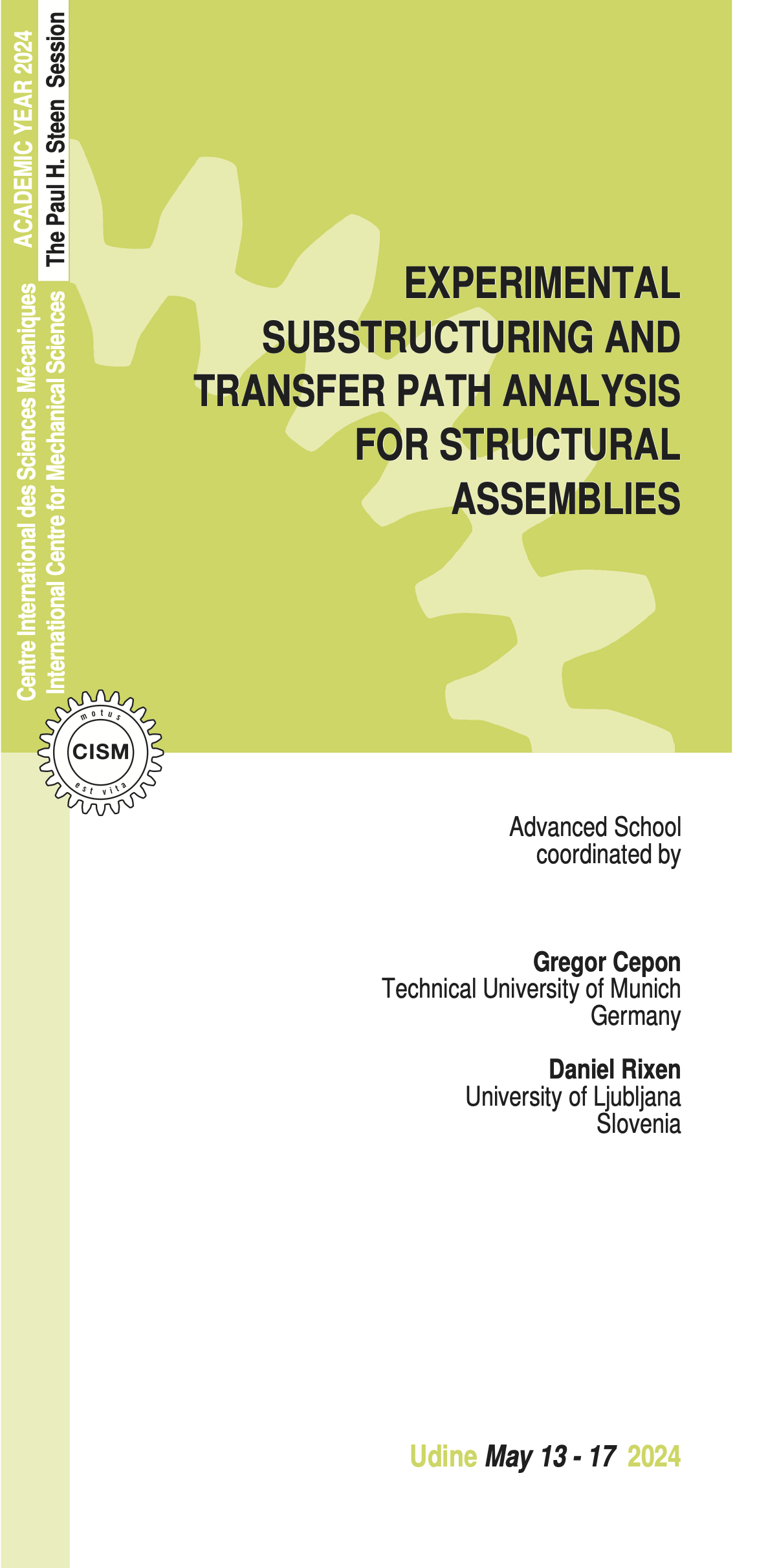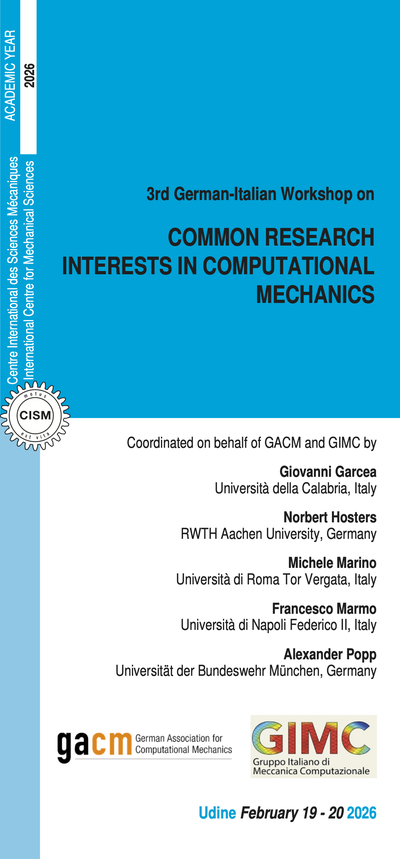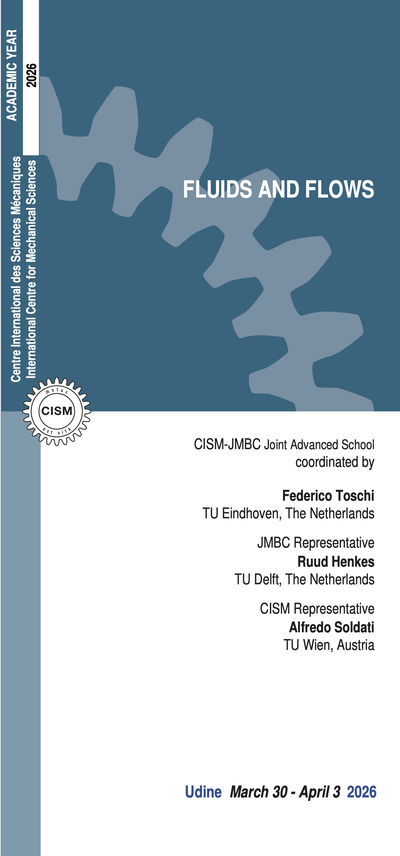The lectures of the course in question will be recorded and made available to the enrolled participants.
Dividing a complex problem in smaller sub-problems is a typical approach in modern engineering. In numerical substructuring, commonly used to perform model order reduction, components of a large structural model are analyzed separately, reduced according to their fundamental dynamics, then re-assembled.
The same approach can be very useful in experimental dynamics, where components are measured separately, and their experimental model assembled for simulation with experimental (or numerical) models of other components. Such substructure-based experimental (or hybrid) strategies can enable efficient modeling in cases where components can hardly be modeled numerically. Unfortunately, rather simple in theory, using experimentally characterized components is highly challenging because measured dynamics always include errors that in most practical cases make the assembled model useless.
Already in the 70’s, first attempts to use substructuring for experimentally measured parts were realized, but with little success. Later, the appearance of affordable and accurate sensors and acquisition systems made it possible to acquire precise transfer function of components at their interface. Over the last ten years, new formulations of the assembly process and advanced signal processing have made measurements suitable for building accurate component models. Also, the concept of blocked forces (known in acoustics for several decades) has recently been properly adapted to structural dynamics and enables a consistent characterization of excitation sources. Proper identification and coupling of substructure dynamics and transfer paths are also essential aspects for hardware-in-the-loop applications. In the field of earthquake engineering, a real-time co-simulation of an experimental and a numerical part is known as "Real-Time Hybrid Substructuring”. In a course of 2018, different aspects of substructuring, both as numerical and as experimental technique, were presented in a graduate course at CISM. In this new course, we will concentrate on experimental substructuring and transfer path analysis, starting from basics and explaining recent advances such as uncertainty quantification, extensions for joint identification (including non-linear joints), specific approaches for high frequency problems (Impulse-based Substructuring) or treatment of complex interfaces in challenging industrial applications. The course will also discuss industrial applications and some software for experimental substructuring.
The course is intended for graduate students either working in the field of experimental dynamics or interested by the field for their future research. The content is also very appealing for engineers in industry who are involved in challenging NVH problems where substructuring-based TPA can help in efficient analysis and troubleshooting. Since the course will start with the basics of substructuring and summarize important experimental techniques, it can be followed with a good general pre-knowledge in structural dynamics, but no specific expertise in substructuring is required.
The course will include the following parts: 1. Introduction, 2. Experimental identification of substructures, 3. Frequency-based Substructuring (FBS), 4. Modal-based Substructuring, 5. Transfer Path Analysis (TPA), 6. Dealing with real data and uncertainties, 7. Non-linear substructuring, 8. Special methods and outlook. It includes academic and industrial examples and computer (industrial code and an open-source code.
D. de Klerk, D. J. Rixen, and S. N. Voormeeren. General framework for dynamic substructuring: History, review and classification of techniques. AIAA Journal, 46(5):1169–1181, 2008.
D. Rixen, T. Godeby, and E. Pagnacco. Dual assembly of substructures and the fbs method: Application to the dynamic testing of a guitar. In International Conference on Noise and Vibration Engineering, ISMA, Leuven, Belgium, September 18-20 2006. KUL.
M. S. Allen, D. Rixen, M. van der Seijs, P. Tiso, T. Abrahamsson, and R. L. Mayes. Substructuring in Engineering Dynamics, volume 594 of CISM International Centre for Mechanical Sciences. Springer, 2020.
M. S. Allen, R. L. Mayes, and E. J. Bergman. Experimental modal substructuring to couple and uncouple substructures with flexible fixtures and multipoint connections. Jnl. Sound and Vibration, 329(23):4891– 4906, 2010.
M. V. van der Seijs, D. de Klerk, and D. J. Rixen. General framework for transfer path analysis: History, theory and classification of techniques. Mechanical Systems and Signal Processing, 68–69:217–244, 2016.
J. Meggitt, A. Moorhouse, K. Wienen, and M. Sturm. A framework for the propagation of uncertainty in transfer path analysis. Mechanical Systems and Signal Processing, (in press), 2020.
J. Meggitt and A. Moorhouse. In-situ dynamic sub-structure decoupling of resiliently coupled assemblies. Mechanical Systems and Signal Processing, (in press), 2018.
D. Ocepek, G. Čepon, and M. Boltezar. Characterization of sensor location variations in admittance- based tpa methods. Journal of Sound and Vibration, 528(2022):116888, 2022.
T. Karaagaclı and H. N. Özgüven. Experimental modal analysis of nonlinear systems by using response- controlled stepped-sine testing. Mechanical Systems and Signal Processing, 146:107023, 2021.
6 lectures on: Modal-Based Substructuring, transmission simulator techniques, extracting fixed-base models using substructuring, introduction to nonlinearities, geometric and friction nonlinearities, identification of non-linearities and non-linear component models, experimental modal substructuring for quasi-linear systems.
6 lectures on: Experimental techniques to measure Frequency Responses of substructures, advanced sensing and excitation hardware, data selection in noisy and inaccurate test configurations, industrial applications, open source tools for experimental substructuring (PyFBS).
6 lectures on: Uncertainties in measurements, Uncertainty propagation in Substructure assembly and in transfer path analysis, in-situ Transfer Path Analysis, completeness criterion at interfaces, transfer path analysis in acoustics.
5 lectures on: Structural coupling and modification of linear systems in spatial domain, identifying connection dynamics, analytical and experimental modal analysis of nonlinear systems, modal Identification of systems with nonlinear joints, nonlinear modification and coupling, nonlinear decoupling and identification of nonlinear connection dynamics, applications.
5 lectures on: General theory primal and dual assembly in structural dynamics, linear model reduction for hybrid modeling, basic theory of Frequency Based Substructuring, theory of decoupling, interface representation using singular vectors, special filtering techniques for measured Frequency Response Functions, identification of bolted joints, impulse-based substructuring. Maarten van der Seijs - VIBES Technology, Delft, The Netherlands 6 lectures on: General theory and available methods for Transfer Path Analysis, connection FRFs using the virtual point transformation, model mixing with the SEMM method, identification of rubber mounts using substructuring techniques, case studies and industrial applications, example of application of commercial code (Vibes) for Transfer Path Analysis and Component Assembly.
6 lectures on: General theory and available methods for Transfer Path Analysis, connection FRFs using the virtual point transformation, model mixing with the SEMM method, identification of rubber mounts using substructuring techniques, case studies and industrial applications, example of application of commercial code (Vibes) for Transfer Path Analysis and Component Assembly.
ADMISSION AND ACCOMMODATION
The course is offered in a hybrid format, allowing participants the flexibility to attend either in person or remotely via the Microsoft Teams platform.
Limited spots are available for on-site attendance and will be allocated on a first-come, first-served basis.
The registration fees are:
- On-site participation: 600.00 Euro + VAT*
Includes a complimentary bag, five fixed menu buffet lunches, hot beverages, downloadable lecture notes.
Deadline for on-site application is April 13, 2024.
- Live Streaming Online Participation: 250.00 Euro + VAT*
Includes downloadable lecture notes.
Deadline for online application is May 1, 2024.
Application forms should be submitted online through the website: http://www.cism.it.
A confirmation message will be sent to accepted participants.
Upon request, a limited number of on-site participants can be accommodated at CISM Guest House at the price of 35 Euro per person/night (contact: foresteria@cism.it)
* where applicable (bank charges are not included) - Italian VAT is 22%.
CANCELLATION POLICY
Applicants may cancel their registration and receive a full refund by notifying the CISM Secretariat in writing (via email) no later than:
- April 13, 2024 for on-site participants (no refunds after the deadline);
- May 1, 2024 for online participants (no refunds after the deadline).
Cancellation requests received before these deadlines will be subject to a 50.00 Euro handling fee. Incorrect payments are also subject to a 50.00 Euro handling fee.
GRANTS
A limited number of participants from universities and research centres who do not receive support from their own institutions can request a waiver of the registration fee and/or free lodging.
Requests should be sent to the CISM Secretariat by March 13, 2024, along with the applicant's curriculum vitae and a letter of recommendation from the head of the department or a supervisor confirming that the institute cannot provide funding. Preference will be given to applicants from countries that sponsor CISM.





